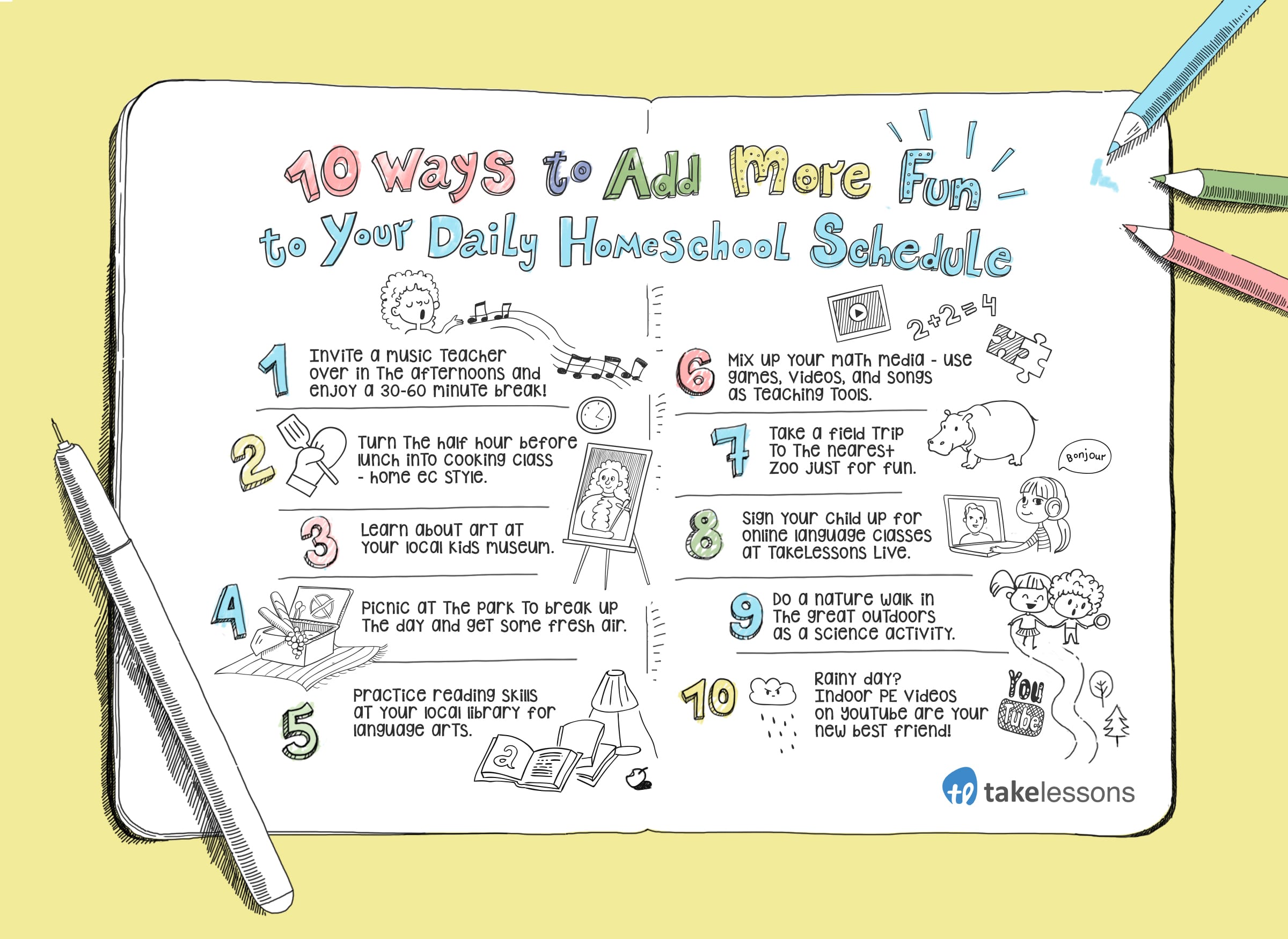
What is your daily homeschool schedule? How can you make it more fun, more engaging, and more educational? Everyone’s learning style is different. The way you arrange your homeschool day will differ from the way another family arranges their day. You can use the homeschool schedule template below to jumpstart your own unique schedule.
What’s The Best Daily Homeschool Schedule?
The best daily homeschool schedule is one that keeps your child excited about learning. For some families, that means scheduling the majority of academics in the morning. For others, it might mean lots of unstructured learning time throughout the day. Still others might find value in an extremely organized schedule.
Here’s a sample homeschool schedule:
- 8:00 am wake up and breakfast
- 9:00 am language arts
- 9:30 am math
- 10:00 am break time
- 10:30 am reading
- 11:00 am science
- 11:30 am lunch
- 12:30 pm art
- 1:30 pm history/social studies
- 2:00 pm music
Again, not all learners are going to focus in the same way. Experiment with your own home education schedule to create a calendar that works for you and your young learner. Let’s look at a few more tips for how to make a homeschool schedule.
How Do You Make a Daily Homeschool Schedule?
The best way to make a daily homeschool schedule is to gain an understanding of how your child learns best, and to design your calendar based on those strengths. Your homeschool schedule doesn’t have to look like anybody else’s. As long as it works for you and your child, then you’re on the right track.
Here are some tips for creating your daily homeschool schedule:
- Make space for your child’s passions: that means scheduling subjects in which your child thrives, whether those are academics or the arts. If your child adores cooking, then make sure cooking class is on the schedule every week. You can even use cooking as an entry point for other subjects, for example, “Math through cooking” or “Chemistry through cooking”.
- Keep it consistent: challenging subjects need to remain on the calendar, even if they are difficult to approach with your child. Keeping consistency week to week even with the most difficult subjects means your child knows that – no matter how challenging – those skills are important to continue learning.
- Get your child involved: your child will likely have valuable input on their schedule, and getting them involved in the decision making process may help them to feel more invested in a positive outcome. They may want to schedule more difficult subjects in the morning, or at the beginning of the week. Or they may have ideas for subjects they really want to learn, that can be worked into the daily homeschool schedule.
- Be open to change: If something on your homeschool schedule isn’t working, don’t be afraid to change it. Your child will grow and evolve, and so should the way you structure your time. When you’re wondering how to make a homeschool schedule, remember that nothing is etched in stone, and everything can be adjusted for continuous improvement.
How Can I Make Homeschooling More Fun?
There are quite a few challenges that come along with homeschooling. Parents have many different roles aside from just teaching, and one of those tasks is administration. It takes a lot of organization and creativity to plan an effective and engaging curriculum.
It’s normal for parents to wonder about how to make homeschooling fun for their kids. This school year, try adding a few new homeschool activities into your weekly calendar to make learning more exciting and interactive for everyone. Incorporating any of these 10 ideas into your daily homeschool schedule will not only add variety to your routine, but many of them will also give you a much-needed break!

Share This Image On Your Site
Please include attribution to TakeLessons.com with this graphic.
From spending more time with the kids to hitting the snooze button as the school bus rolls by, the joys of homeschooling are many. While there are plenty of perks of homeschooling children, parents know it’s not always a breeze.
10 More Fun-Filled Homeschool Tips
The homeschool schedule template above can provide a jumping off point for creating your own. But there are lots more ways to create a home education schedule that keeps your child hooked on learning. Let’s look at a few fun ideas.
1. Invite a Music Teacher Over
Once or twice a week, schedule music lessons in your home so your child can pick up a new, beneficial skill. Music lessons can range from 30-60 minutes, and many local teachers have their own studio if you’d prefer to take a trip outside the house.
Learning an instrument isn’t all fun and games. The right instructor will teach your child to set goals and achieve them, all while building strong practice habits. There are also numerous physical and mental benefits of learning an instrument, such as improved math and reading skills! Consider piano or singing lessons for a well-rounded education.
Jump-start your child’s love of music with this beginner’s tutorial:
2. Have a Pre-Lunchtime Cooking Class
Home economics, or household management, is an often overlooked but necessary subject for any growing child. And what better place to teach valuable culinary skills than in the safety of your own home?
Take the 30-minute time block before lunchtime and use it to teach your child basic cooking techniques. Depending on your student’s age, you can show him or her how to properly peel vegetables, slice different kinds of fruit, read a recipe, or measure out ingredients. Who knows – maybe your child will become the next family chef!
Get inspired with these plant-based holiday recipes:
3. Learn About Art at a Kid’s Museum
Not all homeschool activities have to be at home – you can take your child on field trips too! If your child is a visual learner, a visit to the museum will be the highlight of their week. Get your student’s creative juices flowing by exploring the various exhibits alongside them. As a bonus, most children’s museums offer free or discounted admission on certain days of the week.
Museums present the perfect opportunity for a hands-on art lesson. Make sure to browse the museum’s website ahead of time and discuss the exhibits with your child. After the trip, help your student recreate one of their favorite works of art!
4. Picnic at the Park
It can be easy to stay indoors all day when you homeschool, but never neglect the importance of getting some fresh air every now and then! Break up the day and take a trip to the park for lunch. Let the kids roam or play on the playground for a little while. They’ll get some PE time in, and you’ll leave feeling refreshed.
SEE ALSO: 14 Hilarious Signs Your Family is Ready to Go Back to School
5. Read at a Local Library
There’s something about visiting a library that makes reading more exciting as a kid. Take your child to the local library and let him or her choose from a seemingly limitless number of books in a variety of different genres and themes – it’s language arts paradise!
Having a library card is also an excellent way for your child to learn about being responsible and considerate of others. Pro tip: most libraries offer weekly storytelling programs or puppet shows where the pages really come to life!
You may not know this, but libraries are for much more than just books. You can find a variety of educational materials, including videos and digital resources, at your local branch. Your library card may also give you access to online depositories full of ebooks and magazines that your student will love.
6. Mix Up Your Math Media
Math can be a challenging subject for many children, but it’s important one for your child to have on their regular daily homeschool schedule. Try using a variety of media to boost your child’s progress while making learning fun at the same time. Use math games and catchy songs as teaching tools. You’ll be surprised how mixing up your media can help your child master tricky math concepts.
Of course, the multi-media approach to learning math can be applied to other subjects as well! The internet is rife with compelling ways for your kid to learn history, language, and the arts. Be sure to mix a variety of both physical and digital media so that your child can learn on and off the screen.
7. Take a Field Trip to the Zoo
Trips to the zoo are a blast for children of any age (parents included)! There are many learning opportunities at the zoo as well. Your child will have the opportunity to explore different habitats, learn about the environment, and pick up some new vocabulary. Many zoos also offer educational programs and discounts for kids.
SEE ALSO: 5 Must-Have Back to School Apps
8. Sign Up for Online Language Classes
You’ll notice above that the sample homeschool schedule above specifically highlights languages. There are countless benefits of learning another language for young minds. Aside from learning to respect and appreciate other cultures, studying a foreign language has been found to increase attention spans, improve memory, and boost problem-solving skills.
Other research shows that bilingual students score higher on standardized tests in the areas of reading, social studies, and math. One of the most efficient and convenient ways to get into language lessons is with TakeLessons Live. It’s easy to find the perfect teacher for your kid, and schedule lessons from the comfort of your home. You’ll find that online language lessons are a rewarding and effective homeschool activity.
9. Do a Nature Walk in the Great Outdoors
Looking for a new science activity to engage the senses? Searching for a way to get your child away from the screen and in touch with the natural world? Try doing a nature walk with your child in your community. Prepare a scavenger hunt, go bird watching, or see how many different types of plants your child can spot.
Experiment with different environments. If you live near the water, go for a beach walk. If you live near a wooded area, head out on a trail adventure. Don’t forget to bring your binoculars!
10. Check Out Indoor PE Videos
Physical education videos on the computer might sound a little contradictory, but in cold and rainy seasons, YouTube can be your new best friend! There are dozens of kid-friendly YouTube channels designed with the sole purpose of facilitating indoor PE sessions. Just because you can’t leave the home doesn’t mean your child can’t get some much-needed exercise in.
From yoga to swing dance, guided videos can be an outstanding way to get your youngsters moving. And of course, getting the blood flowing will help your child get their wiggles out, so they can fully focus when it’s time to focus on academics.
Get started with this accessible yoga tutorial:
Create a Daily Homeschool Schedule That Works for You And Your Family!
Remember, your family’s daily homeschool schedule will look different than another homeschool family’s schedule. Keep experimenting, use the sample homeschool schedule template above as a guide, and remember that you’ll likely need to adjust your homeschool schedule as your child develops.
As a homeschool teacher, there’s no need to be the only instructor in your student’s life. By connecting your child with TakeLessons instructors, they can benefit from working with a variety of experts. From language lessons to math tutors, you can find the perfect teacher for your child, and have a great addiction to your homeschool activities list!
Do you have any other homeschooling ideas that make learning more fun? Share your suggestions by leaving a comment below!
Jessica Dais
![10 Ways to Add More Fun to Your Daily Homeschool Schedule [Infographic]](/_next/image?url=https%3A%2F%2Ftakelessons.com%2Fblog%2Fwp-content%2Fuploads%2F2017%2F08%2Fhomeschool.jpg&w=3840&q=75)
